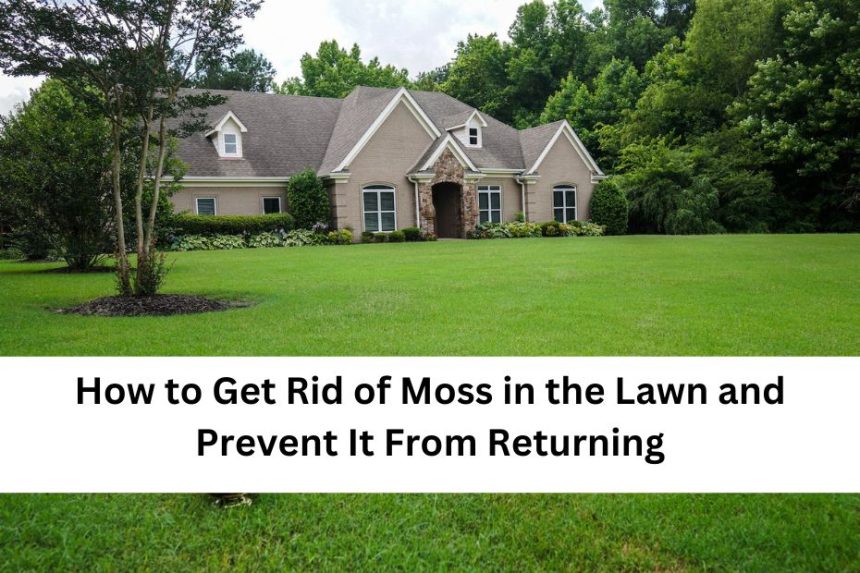Introduction
Moss, with its velvety green appearance, might seem harmless at first glance. However, left unchecked, it can quickly take over a lawn, suffocating grass and creating an unsightly mess. Understanding how to effectively remove moss and prevent its return is crucial for maintaining a lush, healthy lawn.
Understanding Moss
Moss is a simple, non-vascular plant that thrives in damp, shaded environments. Unlike grass, which has roots, stems, and leaves, moss lacks true roots and reproduces via spores. It’s well-adapted to low light levels and moist conditions, making it a common sight in shaded areas with poor drainage.
Identifying Moss in Your Lawn
Identifying moss is relatively easy due to its distinctive appearance. It forms dense, low-growing patches that can range in color from bright green to yellowish-green. Unlike grass, moss lacks a defined blade structure and feels soft and spongy to the touch.
Causes of Moss Growth
Several factors contribute to moss growth in lawns, including excessive shade, compacted soil, poor drainage, and acidic soil conditions. These conditions create an ideal habitat for moss to thrive while inhibiting the growth of grass.
Natural Methods to Remove Moss
Manual removal is often the first step in tackling a moss problem. Using a rake or dethatching tool, gently loosen the moss from the soil surface, taking care not to damage the underlying grass. Increasing sunlight exposure by pruning overhanging branches can also help discourage moss growth.
Chemical Treatments for Moss Removal
For severe moss infestations, chemical treatments may be necessary. Moss killers containing ferrous sulfate or potassium salts can effectively kill moss without harming grass. Herbicides labeled for moss control can also be used, although they should be applied carefully to avoid damaging desirable plants.
Preventing Moss from Returning
Preventing moss from returning requires addressing underlying issues that contribute to its growth. Cultural practices such as improving soil drainage, aerating compacted soil, and adjusting soil pH can help create conditions that are less favorable for moss.
Using Moss as an Indicator
Moss can serve as a useful indicator of underlying soil conditions. By understanding the environmental factors that promote moss growth, homeowners can take proactive steps to improve soil health and prevent future moss problems.
Alternative Approaches
For those seeking eco-friendly alternatives to chemical treatments, biological controls such as beneficial nematodes or microbial soil additives can help suppress moss growth naturally. These methods work by promoting a healthy soil ecosystem that is less hospitable to moss.
Common Mistakes to Avoid
Over-fertilizing, ignoring drainage issues, and using incorrect moss removal methods are common mistakes that can exacerbate moss problems. Taking a holistic approach to lawn care and addressing underlying issues is key to effective moss management.
DIY Moss Removal Tips
DIY enthusiasts can create homemade moss removal solutions using ingredients such as vinegar, baking soda, or dish soap. When applying these solutions, it’s important to follow proper dilution ratios and application techniques to avoid damaging grass or other plants.
Professional Moss Removal Services
In cases of severe moss infestation or when DIY methods prove ineffective, homeowners may opt to enlist the help of professional moss removal services. These professionals have the expertise and equipment necessary to safely and effectively eradicate moss from the lawn.
Maintaining a Moss-Free Lawn
Maintaining a moss-free lawn requires ongoing effort and attention to detail. By implementing long-term strategies such as proper lawn maintenance, regular overseeding, and seasonal adjustments, homeowners can enjoy a healthy, vibrant lawn free from moss.
Conclusion
Getting rid of moss in the lawn and preventing its return requires a multi-faceted approach that addresses both current infestations and underlying environmental factors. By understanding the conditions that promote moss growth and implementing proactive management strategies, homeowners can maintain a lush, moss-free lawn year-round.
FAQs
- Can moss be beneficial for the lawn? Moss can help retain moisture in the soil and prevent erosion, but excessive moss growth can smother grass and other plants.
- Is moss harmful to pets? While moss itself is not toxic to pets, some chemical moss treatments may pose a risk if ingested. It’s best to keep pets off treated areas until the product has dried completely.
- How long does it take to remove moss from a lawn? The time it takes to remove moss from a lawn depends on the extent of the infestation and the methods used. Manual removal may take several weeks to see noticeable results, while chemical treatments can be more immediate.
- Can moss grow in sunny areas? While moss prefers shady, moist environments, certain species can tolerate some sunlight. However, moss is less likely to thrive in sunny areas with well-drained soil.
- Is it possible to prevent moss without chemicals? Yes, cultural practices such as improving soil drainage, increasing sunlight exposure, and overseeding with shade-tolerant grass can help prevent moss without the need for chemical treatments.

